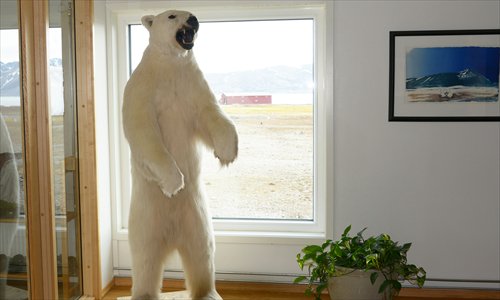HOME >> WORLD
Bearly getting along
Source:AFP Published: 2015-8-9 18:28:01
Scientists and polar bears live side by side on Norwegian island

A view of Kongsfjorden fjord near the scientific base of Ny-Alesund. Photo: AFP
Residents of the remote Arctic settlement of Ny-Alesund never lock their homes - happy to sacrifice privacy for the option of barging through the nearest door if a polar bear attacks.
The research center, formerly a coal mining town, is perched on the Norwegian island of Spitsbergen, which is also home to a sizeable polar bear community and one of the most extreme landscapes on Earth.
The northernmost permanent human settlement, Ny-Alesund hosts about 150 scientists, researchers and technicians during the Arctic summer, dwindling to a handful of caretakers in the colder months.
New arrivals are swiftly initiated into the dos and don'ts of life in close quarters with a formidable predator.
"If you see a bear, just enter any building and call the caretaker. His number is marked on every telephone," Katherin Lang, head of the Franco-German Awipev institute - one of several research bases - tells newcomers.
Two days earlier, two female bears and their two cubs were spotted just four kilometers from the base, feeding on a stranded walrus.
"It is forbidden to go in that direction, even if you have a gun," said Lang - a warning that is echoed in notices put up in the cafeteria.

A stuffed polar bear stands in the scientific base of Ny-Alesund in the Svalbard archipelago on July 23. Photo: AFP
Always take a gun
Encounters between humans and polar bears on Norway's stunning Svalbard archipelago, of which Spitsbergen is the largest island, are rare.
In March this year, one attacked a sleeping Czech tourist, causing injuries to his face and arm before fellow campers shot the animal dead. Every new arrival at Ny-Alesund must learn to shoot if they wish to leave the base.
The most important message, "Always be vigilant; bears could be anywhere and they are unpredictable," Sebastien Barrault, the scientific advisor of a Norwegian company running logistics at the site.
"A gun is your passport for leaving the town," he said.
Svalbard is roughly one-and-a-half times the size of Switzerland, and home to some 3,000 polar bears - outnumbering the 2,500-odd human inhabitants.
There are some 20-25,000 polar bears left on Earth, and the species is listed by the International Union for Conservation of Nature as "vulnerable" - meaning it faces a high risk of extinction in the wild.
Polar bears have been hunted to excess, and are at further risk as sea ice, their principal hunting ground, is melting due to global warming.
Shooting a bear, said Barrault, must always be "the last resort" - used only to protect human life.
Adult male polar bears can weigh anything from 350 to over 600 kilograms and run at speeds of up to 40 kilometers per hour over short distances.
Predators can outrun humans
"Never run," when confronted by a bear, advises Barrault. Rather, one should "make lots of noise" using something like a starter gun to try and scare the animal away.
"Often, they will turn away, but a hungry bear or a mother with her cub are more dangerous," he said.
Polar bears are a "nightmare" for Dutch ornithologist Maarten Loonen, who has been working at Ny-Alesund for more than two decades, studying migratory geese and Arctic sterns.
"As far as possible, we travel in pairs," he told AFP, freely admitting his fear of the animals. "I tell my students: 'the polar bear views you as potential prey.'"
According to Loonen, there were far fewer bears in this western part of Spitsbergen when he first started visiting.
"In 1988, there weren't even any [polar bear] guidelines and I would camp alone and without a gun," he recounted.
Bears mainly occupy the eastern, colder part of Spitsbergen, where there is more ice.
"In recent years, the bears have been exploring new territory," said Barrault, and are "coming closer to Ny-Alesund."
On the last Sunday of July, a female bear and her cub passed right through the village at dawn, but without incident.
There has never been an attack on a resident of Ny-Alesund, and only five fatal confrontations in Svalbard in the past 40 years.
Polar bears mainly feed on seals, but also scavenge on the carcasses of whales, walruses, and other animals.
When food is scarce, they may seek out prey like reindeer, rodents or fish, and forage for eggs or even human garbage - which may bring them in conflict with people.
Posted in: Europe